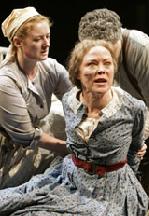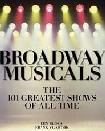SITE GUIDE
SEARCH
REVIEWS
FEATURES
NEWS
Etcetera and
Short Term Listings
LISTINGS
Broadway
Off-Broadway
NYC Restaurants
BOOKS and CDs
OTHER PLACES
Berkshires
London
California
New Jersey
DC
Philadelphia
Elsewhere
QUOTES
On TKTS
PLAYWRIGHTS' ALBUMS
LETTERS TO EDITOR
FILM
LINKS
MISCELLANEOUS
Free Updates
Masthead
Writing for Us
A CurtainUp New Jersey Review
Mrs. Packard
|
You may think your own thoughts when you are thinking right.
— Rev. Packard to Mrs. Packard Color comes into your cheeks when you are being provocative. It's very attractive.— Dr. McFarland |

Fiana Toibin, Kathryn Meisle, and Ray Wiederhold in Mrs. Packard
(Photo: T. Charles Erickson) |
The story is based on a case that occurred in Illinois starting back in 1860. Although it wasn't legal for a wife to be kept prisoner in her home without a trial, it was quite legal for a husband to put his wife in an insane asylum without a trial or evidence of insanity. Mrs. Packard's husband, the Reverend Theophilus Packard, a conservative Calvinist minister, did just that, acting perfectly within his rights. Mrs. Packard had continually and vocally disagreed with his religious beliefs, and the Reverend said that he feared for the souls of their six children. At his request, Elizabeth was taken from their home and incarcerated in the insane asylum in Jacksonville, Illinois.
Advance literature for this production introduces the major theme of the play in its praise for Mrs. Packard's heroics as "a triumphant account of one woman's determination to right a system gone terribly wrong." Clashes with the medical superintendent of the asylum are promised and it is hinted in some material that she will have a profound impact on the doctor. Cover artwork on the show's program, with great economy and style, advances another major theme— the importance of Elizabeth's writing, which is her weapon. Letters, evidently, were regularly smuggled out to asylum trustees and others who could affect change. These were the expectations set up in advance. However, the actual experience of the play diverges from these intentions and anticipations in important ways.
Mrs. Elizabeth Packard appears for most of the play to be less interested in righting a system gone wrong than she is in expressing her personal outrage and venting her anger at her husband, insisting that he beg her forgiveness. Elizabeth and the medical superintendent are in conflict, yet she appears to be impressed by him, at least initially. He offers her freedom if she will sign a pledge to refrain from disruptive behavior. She refuses to sign. But the emphasis is not on a battle of wits. In fact, she speaks foolishly to him. Her impact on the doctor could come later, after the events of this play.
Occasionally Elizabeth is shown writing on found paper scraps in the asylum, but this factor is underplayed. She evidently wrote much more prodigiously than we are made aware of. It's not until the epilogue that the extent or influence of her writing is learned.
The business of the play concerns itself mainly with Mrs. Packard's obstinacy, her efforts to be accepted as sane, and the daily horrors of the asylum, rather than with a brave, big-picture, society-changing determination on her part, which develops after the action of the play. Eventually, after she had made her choice to remain incarcerated based on personal issues, she pitches in admirably and helps others.
It's hard to admire the major characters. There's Elizabeth Packard, who is compelled to speak her mind, and damn the consequences to anyone else. Kathryn Meisle makes an appropriately feisty Elizabeth. John C. Vennema is scarily believable as the obdurate Reverend Theophilus Packard, who sees no problem with his wrongheaded treatment of his wife, because her behavior is "not fitting." (An item of evident interest and amusement to the local audience is that the Rev. Packard attended the Princeton Theological Seminary, which is identified as very conservative.) Together, Theophilus and Elizabeth are a rock and hard place couple.
And there's Dr. McFarland (an excellent Dennis Parlato), the asylum's director, with his involvement in all facets of the institution and his personal interest in Elizabeth, who, at one point offers him her heart. There's a warden (Fiana Toibin) who abuses her bit of power.
On the side of the angels, the dreaded 8th ward has a kind warden (Julie Boyd), and among the inmates there's a Mrs. Stockton, played in an interesting manner by Georgine Hall. The brightest spot in this landscape is the Calvinist head trustee (a dignified Robin Chadwick) who, even though he supports the biannual Lunatic's Ball and knows what transpires in the asylum, recognizes that Mrs. Packard has been incarcerated for using, not losing, her reason.
Is this simply a transplanted 19th Century melodrama? Are we meant to support the major theme by hissing the villains and cheering on poor beleaguered Mrs. Packard? Certainly she was the victim of a system that more than tolerated the repression of women, a horse which is beaten here until quite dead.
It turns out, however, that this play is more interesting than it initially appears. A contrapuntal element becomes a compelling and recurring minor theme that eventually threatens to eclipse the major thrust: If Mrs. Packard was a victim, it was with her full and conscious complicity. She knew how the game was played and what the stakes were, and she elected to remain in a mad house participating in her own victimization. The decision was made out of self-concern and personal anger at her husband and his repressive beliefs. At what point did she get beyond herself and move on, trying to correct wrongs? It wasn't right away. Does this, then, inadvertently become a tale of her pride and lack of discernment as she brings severe consequences down upon herself and her children?
The tale takes place within an impressive, depressing architecture with fine stage engineering designed by the much respected Eugene Lee. The set includes a bridge and moving parts that give a good metallic prison "clank." The upper level is employed for those giving testimony about Mrs. Packard. The sound and lighting designs are both so well executed as to be of a piece, fully incorporated into the set and the action.
At times this is an ordeal to watch, and not because it is set in a mental institution. The comings and goings on stage, though fluid, are conventional. Done in broad, repetitive strokes, this old fashioned kind of play set in a stodgy, repressive time and place is itself rather stodgy. Despite the creative staging of cleverly interspersed testimony, the main stage activity cries out for more inspired staging.
In the epilogue important elements of the story are imparted in a narration that champions the indomitable, heroic Mrs. Packard bearing up under adversity. It also presents the consequences of her actions. The niggling, growing sense of the underside of her resistance surfaces along with the possibly unintentionally subversive theme of personal responsibility. Does Mrs. Packard, who wants the system to be responsible, ever acknowledge the role of responsibility in her own life? The care of one's children is a crucible for morality. Does Mrs. Packard treat her six innocent children any better than her husband or the system treated her? They were sacrificed on the altar of her indignation before the larger, societal issues even kicked in.
Mrs. Packard——crusading heroine or obstinate reprobate? There's much food for thought here.
|
Mrs. Packard
by Emily Mann Directed by Emily Mann Cast: Kathryn Meisle, Dennis Parlato, John C. Vennema, Fiana Toibin, Julie Boyd, Molly Regan, Georgine Hall, Jeff Brooks, Robin Chadwick. Ensemble: Karen Christie-Ward, Beth Dzuricky, Mitchell Michaliszyn, Quinn Warren, Ray Wiederhold Set Design: Eugene Lee Lighting Design: Jeff Croiter Original music and Sound Design: Rob Milburn and Michael Bodeen Costume Design: Jennifer von Mayrhauser Running time: Approximately 2 hours with one 15 minute intermission Berlind Theatre, McCarter Theatre Center. Princeton, NJ 05/04/07 to 06/10/07 Reviewed by Kathryn Osenlund based on 05/11 performance. |

Easy-on-the budget super gift for yourself and your musical loving friends. Tons of gorgeous pictures.

Leonard Maltin's 2007 Movie Guide

At This Theater
Leonard Maltin's 2005 Movie Guide

 >
>

